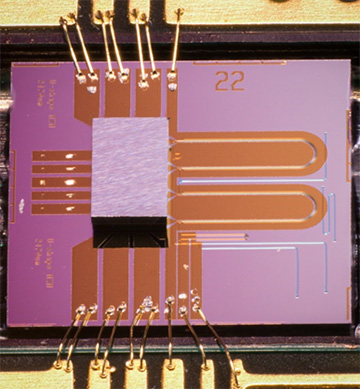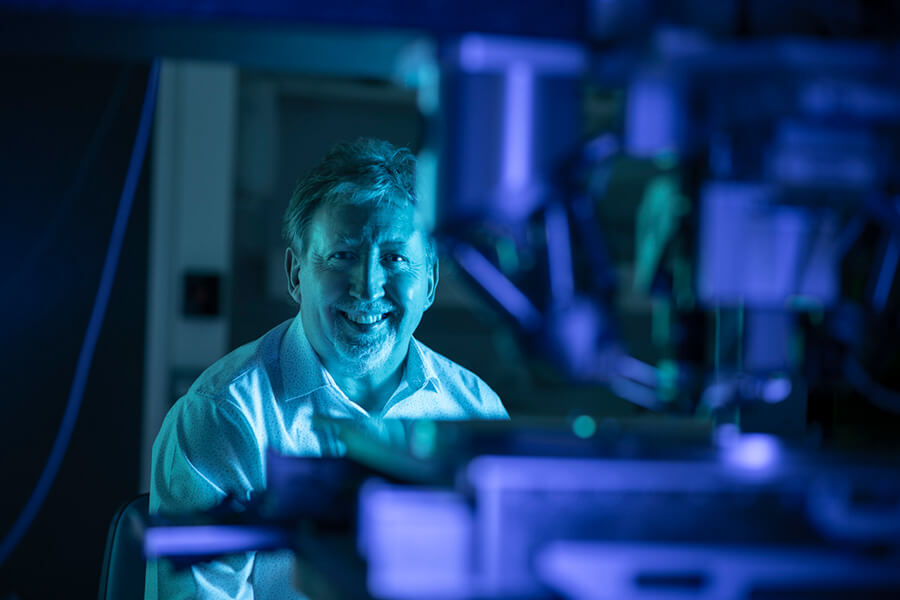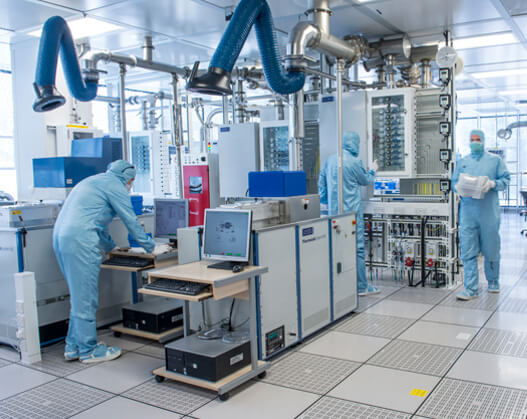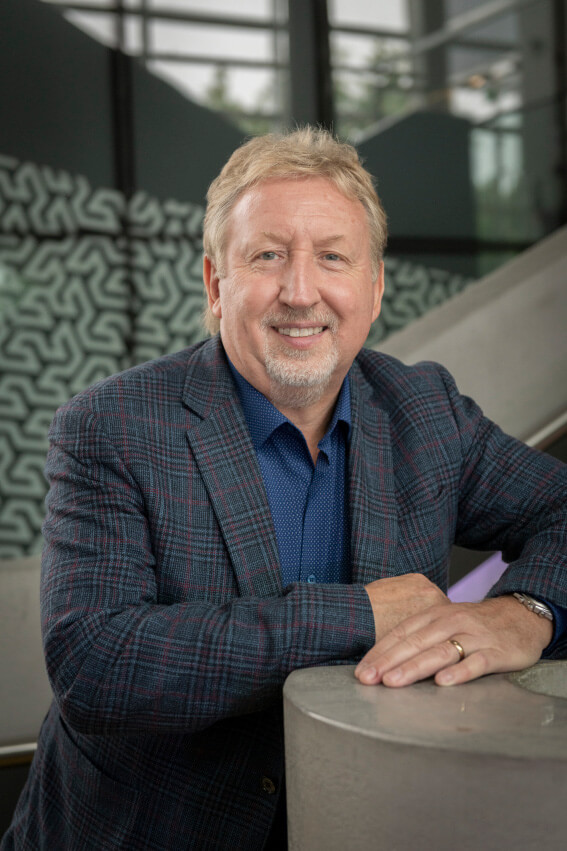Graham Reed in the lab. [Image: Courtesy of G. Reed]
In August 2023, Graham Reed, a pioneering figure in silicon photonics, took over as the director of the University of Southampton’s legendary Optoelectronics Research Center (ORC), previously run for 28 years by Sir David Payne. Reed—who will give a plenary talk at Optica’s upcoming British and Irish Conference on Optics and Photonics (BICOP)—recently chatted with OPN about the ORC’s strengths, where it’s headed, the prospects for silicon photonics, and UK photonics in world markets.
You’ve stepped into a new leadership role at the ORC. Could you talk a bit about what you did before that, and how you built the silicon photonics program there?
Graham Reed: I was previously at the University of Surrey in the UK. I started the silicon photonics activity at Surrey way back in 1989, and it’s been recognized that we were one of the founding groups of the field.
Now, the ORC at Southampton is world renowned in photonics—but it didn’t have silicon photonics. So in 2012, they recruited my entire group from Surrey. That meant that 13 of us moved to Southampton—three senior people, some more junior researchers and some Ph.D. students.
This year, the silicon photonics group at the ORC is 55 people—56 of you include me. So obviously, there’s been substantial growth.
What do you think accounts for that?
I think there are probably three reasons. First, Southampton has one of the best academic cleanrooms in Europe. And that’s a big attraction, because it enables you to have a crazy idea, fabricate it, fix what’s wrong, refabricate, reiterate, do short-loop experiments. You become much more productive.
“Southampton has one of the best academic cleanrooms in Europe. And that’s a big attraction.”—Graham Reed
Second, silicon photonics has obviously grown in stature and demand and application areas. So it became somewhat easier to obtain funding, especially since we had a very strong track record in the field in the UK.
And then third, I think at the ORC you’re surrounded by lots of very high-quality photonics people in related fields. So it enables you to grow, and there’s a lot of other laboratories and equipment that you can use and access. That whole ecosystem at Southampton, and the changing environment in the world, enabled us to be very successful and grow.
Now you’ve taken over as the director of that wonderful ecosystem. How does it feel following in the footsteps of you predecessor, Sir David Payne, who led the ORC for 28 years?
Well, they are big shoes to fill, for sure. David is one of the most recognizable people in the entire field of photonics. So clearly, you go into the job with a little trepidation. …
Cleanroom at Southampton’s ORC. [Image: Courtesy of G. Reed]
But the ORC is really a world-class place, and world-class people want to work with us. So in terms of thinking about what’s ahead, what I want to do is more of the same. Several people have asked me, “Will the direction of the ORC change? Will it be different? Is it going to become more of a conventional university department, with teaching and undergraduates?” The answer is no—it’s going to remain an elite research institute for as long as I’m in the chair.
Now, that comes with its own challenges—particularly as photonics is making more of an impact and becoming more mainstream in many ways. It’s that much more difficult to recruit the very high-quality people—at all levels, in fact. And equally, our own success means that we lose people.
How do you mean?
Well, for example, Microsoft recently bought an ORC spin-out called Lumenisity. And when that happens, some of our senior staff go with them. And these are very well known, very senior people in their own right. Of course, that’s a big loss to the ORC on an operational level. But we have to also look upon it as a success.
So one of the things I need to do, of course, is replace those folks with equally good people. But equally, it’s an opportunity to bring in and develop and help the some of the more junior folks, to give opportunities to them—all of those good things that we all want to do, to enable the leaders of tomorrow to develop themselves.
What else are you looking at to move the ORC ahead?
There are a few other operational things I think we need to address. We need to modernize in some ways, things like that. But these are less significant. The high-level thing is to retain the elite nature of the institute.
And the cleanrooms, which I mentioned earlier, are something of a unique asset that most universities don’t have. We’ve got a silicon fab in there; we’ve got fiber-pulling towers; we’ve got bio labs; we’ve got the only deep-UV lithography tool in academia in the UK. In fact, there are really two planar photonics cleanrooms—there’s what I would call the “clean” cleanroom, and then there’s the slightly “dirtier” cleanroom, where you can do the weird and wonderful experiments with a bit more freedom.
“Several people have asked me, ‘Will the direction of the ORC change? Will it be different? …’ The answer is no—it’s going to remain an elite research institute for as long as I’m in the chair.”—Graham Reed
The combination of those things is unique. And it does enable the entire ORC to be more successful and develop things more practically than a lot of people have the opportunity to do. But there is a challenge in continuing to resource that. So that’s one of the other things that we must maintain.
In that spirit, we are just about to install two new electron beam lithography tools. Now, for the silicon photonics activity, we mostly use the deep-UV scanner I mentioned, because that’s essentially an industry tool, and we use that in silicon photonics because it makes the interface to industry and the tech transfer that much easier.
But the ability to add two state-of-the-art electron beam tools enables a lot of the other researchers, as well as the silicon photonics researchers, to mimic an even higher-quality foundry fabrication service. That will undoubtedly give us the best academic lithography capability in Europe—and possibly beyond. These are the sort of things we have to keep doing to keep that cleanroom at the level it needs to be to support the vast variety of activities that we have.
Let’s talk a bit more broadly about the domain of silicon photonics. What are the biggest milestones for the discipline that lie ahead, and where do you think it will have its biggest impact?
That’s a difficult question. The application areas for silicon photonics have grown so much, and the priorities for each of those is different.
Telecom/datacom—you know, the communications in data centers—is really the only place where silicon photonics is now a proper commercial application. And the priorities there are for faster, smaller, more power efficient, and low cost, of course. Now, silicon is inherently a low-cost activity—the electronics industry has demonstrated that. Silicon photonics production uses pretty much the same processes as microelectronics. So it’s not a huge leap of faith to understand that potentially, it can be a lower-cost technology.
But it’s the performance areas that that particular application in communications is looking for. I think the modulator has always been the most difficult component in that entire activity. And it’s come a long way. In the research labs, the performance is even better than in the commercial world. And actually, the ORC now holds two of the world records for data rates for different types of modulators.
In fact, some of that is what I’ll be talking about at the upcoming BICOP meeting. We have an integrated transmitter—an electronic driver, flip-chipped onto one of our photonic circuits—and it has some very high-speed results. The talk will be an opportunity to give a few details about how we achieved a very high level of performance.
And what are some of the things that go into those kinds of results?
Well, I think the results show that even in a university fab, albeit a very high-quality university fab, you can do very high-quality manufacturing and fabrication. But it’s also about the way you design things. We’ve been pushing something we call co-design.
You know, we used to make a modulator over here, and modulator driver over there in the electronics, and then put them together. And the performance was limited by the least good performance of either one of those things. In the codesign, what you do is you put them together and treat them as an entire system, and co-design them. So you might design your modulator or the driver in a way that’s slightly different than if you designed it in isolation. You also need to take account of how the integration process affects performance. And when you do that, you achieve an overall improvement in performance.
So co-design is a big deal. Heterogeneous integration is also important for that application; that’s sort of already happening, but improvements will happen. There’s a big push in the whole field for the interfaces to be able to be able to handle more channels, that type of thing.
You said the demands of other applications beyond communications are different. Could you talk about some of those?

Reed says co-design and heterogeneous integration have allowed ORC to push the performance envelope in integrated photonics for telecom/datacom. [Image: Courtesy of G. Reed]
There are lots of emerging applications. There’s a huge interest in health care sensing, for example, and all the priorities are completely different for silicon photonics in that arena. There’s AI. There’s lidar. There’s quantum, for which the big opportunity for scale-up is in silicon photonics. Space applications are becoming very important. 6G, underpinning mobile communications. The list goes on.
All of these things are important emerging applications for silicon photonics. They’re much less advanced, obviously, than the data center activity, but they all represent opportunities for researchers, for startups, for the bigger companies to become involved in those areas.
I was speaking at a recent conference, and someone asked me a similar question. And I answered that I’m kind of jealous of some of the students entering the field now, because there’s so many opportunities in silicon photonics. When I started, there was really nothing. Now there are huge opportunities in silicon photonics—regardless of whether you want to be a researcher, or an industrialist, or an entrepreneur. It’s a great time to enter the field.
You mentioned AI, which a lot of people are talking about as a potential application.
Yes. I think what photonics brings to AI is the capability to do parallel processing and thus to speed up the processes. You can make parts of your neural network in photonics; you can perhaps reconfigure certain elements in photonics; you can program certain parts of it in photonics.
And you of course gain in speed both from the parallelism and from the fact that you’re operating at the speed of light, where electronics might be inherently slower. Of course, there’s the need to interface to electronics, but there’s a need for that in all of silicon photonics applications.
Obviously it’s early days, and there’s huge amounts to do in the field. But already there are companies springing up; there are startups; there are large companies doing things. And there’s a whole host of approaches. So again, it’s an area that’s extremely fertile for innovation, and it brings together multiple disciplines. You’ve got the out-and-out computer scientists; you’ve got the electronics people; you’ve got the photonics people; you’ve got the device designers; the fab people—you need them all.
You also noted lidar as well as an application area. What are the drivers for silicon photonics in that sector?
Lidar is another one of those emerging applications that looks like it will be extremely important.
“There are huge opportunities in silicon photonics—regardless of whether you want to be a researcher, or an industrialist, or an entrepreneur. It’s a great time to enter the field.”—Graham Reed
You know, for many years, one of the issues for silicon photonics was: Where’s the true mass-market application going to come from? Data centers constitute a commercial application, but the volumes are not enormous. Whereas with lidar, there are lots of applications. And for the application that most people are talking about, autonomous vehicles, if you imagine if a given car is going to be six, seven, eight lidar chips, that is a mass market. And miniaturization is vital.
You’re involved with a fascinating startup venture in that area, Pointcloud. How do things stand there?
Pointcloud has, I think, a unique approach, the “flash lidar” approach. And that approach provides some of the best data in the world.
I think one issue for the field of lidar is that there are too many lidar companies. There have to be fewer of them. And I think the position of Pointcloud is very good, in the sense that the technology is very strong. You can do hundreds of meters for very low powers compared to some of the other technologies; you’re very efficient with the photons; you get a very low-noise system, and so on. There’s lots of advantages to doing it the way Pointcloud is doing it.
And that in itself is an advantage if the industry wants the best solution. How will it pan out? Well, I don’t have a crystal ball, but my hope is that Pointcloud will play an important part, because the technology and the results so far are so strong.
How did you get involved with this venture?
That’s an interesting story. The CEO, and the guy who really came up with the idea for founding Pointcloud, Remus Nicolaescu—I met him many years ago when I was a consultant to Intel and Intel was setting up its silicon photonics activity. And even after he left Intel, we would keep in touch.
Every now and again Remus would try out an idea on me for a startup. And on several occasions, it was okay, but it wasn’t the greatest idea I’d ever heard. When he came up with a lidar idea, though, I was on board straightaway. Initially this was going to be his company and I was going to be an advisor. But he detected my enthusiasm, and he said, “You know what, do you want to be involved in this?” So I dragged in one of my colleagues, Dave Thompson, who is also a co-founder.
It gives us a unique way of operating. We have such a good fab at Southampton, Pointcloud can put a research contract out to Southampton. We can try out some of the things that we want to do to advance the technology in the benign university environment, before we have to put it into the very expensive foundry. And so we’re essentially like a research arm of Pointcloud under contract at the university. It seems to work pretty well.
I’d like to close with a couple of questions about UK photonics, from your new perspective running a world-class research institution. The UK is now back as an associate member in Horizon Europe, the big EU funding framework program. What sort of impact do you think that will have?
Graham Reed. [Image: Courtesy of G. Reed]
Well, with respect to rejoining Horizon Europe, what I would say is, it’s about time. It’s been something that the senior folks in the photonics community have been lobbying for, for some time.
We have always been a strong player in Europe, and during the time we were not formally part of Horizon, we still were able to contribute to some projects because there were interim arrangements. But what was completely noticeable, right from the Brexit vote, was that we were not being invited into the same number and level of consortia that we used to be, and we were not participating as much.
And I think that’s because the Europeans were hesitant, and understandably so. They didn’t really know if we would be reliable partners—whether we would have to drop out at a moment’s notice; what the underlying politics was surrounding that; did the Europeans want us in; was it going to affect the scores they achieved on their proposals, and so on. It was a very uncertain time.
So hallelujah; we’re back in. It’s an important part of the funding ecosystem in the UK and something we’ve missed. And working with our European colleagues, many of whom we have very close relationships with, was jeopardized for a long time. So this is very good news and, in my view, should have happened earlier.
In terms of the impact for the ORC of the UK rejoining Horizon, I think we make impact in most of what we do. So it’s just a different way of resourcing that. We have very theoretical guys, working from the fundamentals of physics, all the way through to people who are very close to industrial applications. And there’s opportunities in Europe for all of those activities.
But particularly, I think, we make impact in working with our industry partners. There’s quite an entrepreneurial feel about the ORC at Southampton—I think 18 companies in the recent past have their origins here. So colleagues are really encouraged to look at entrepreneurial activities. That’s not directly related to European funding, but it is a mindset that means we work closely with industry.
Looking beyond Europe, do you have any thoughts on the strengths that the photonics industry brings to the UK in world markets?
Well, I think the UK photonics community is very strong and diverse. And it’s not always obvious that that’s the case. Many folks would regard photonics as an enabling technology, so you might look at an application, but you don’t always realize that there’s photonics underpinning something within that application.
“I think the UK photonics community is very strong and diverse. And it’s not always obvious that that’s the case.”—Graham Reed
The UK Photonics Leadership Group, which is headed by John Lincoln, has really done a good job in explaining to the UK government the importance of photonics, the contribution it makes to the UK economy. And they have come up with statistics indicating that a majority of UK photonics companies export more than half of their output, and that four out of ten UK photonics firms export more than 75% of what they make. These are very significant numbers.
So UK photonics is definitely serving the worldwide community. Of course, the UK is a much smaller country than the US, for example—but I think it’s fair to say the photonics community here is punching above its weight. It’s an extremely important part of the UK economy.



